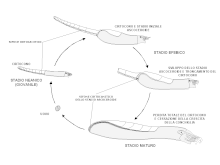Ascocerida
| Ascocerida Temporal range: Ordovician–Silurian |
|
|---|---|
 |
|
| The ontogeny of Ascoceras, an Ascoceridian | |
| Scientific classification | |
| Kingdom: | Animalia |
| Phylum: | Mollusca |
| Class: | Cephalopoda |
| Subclass: | Orthoceratoidea |
| Order: |
Ascocerida Kuhn, 1949 |
The Ascocerida are comparatively small, bizarre Orthoceratoids known only from Ordovician and Silurian sediments in Europe and North America, uniquely characterized by a deciduous conch consisting of a longiconic juvenile portion and an inflated breviconic adult portion that separate sometime in maturity.
The juvenile portion of an ascocerid consists typically of a narrow, circular cyrtocone that underwent periodic truncation. Cumulative length, included broken off segments, may have reached about 20 cm (8 in) in the largest. The siphuncle is located half way between the shell axis and the venter, is thin walled and tubular with short, orthochoanitic septal necks and segments that are only slightly inflated. The juvenile portion is known as the deciduous conch, as it is shed in a similar manner to deciduous trees losing their leaves.
The adult, or mature ascoceroid conch, as it is referred to, consists typically of an expanded exogastric brevicone with special unique features. The apical end is formed by the septum of truncation which is about three times s thick as the normal internal septa and about as thick as the external shell itself. The septa become confined to the dorsal side of the shell resulting in a series of dorsal chambers, or camerae, that provided stabilizing buoyancy.
The ascocerid shell, or conch, is the thinnest and most fragile of any orthocone or cyrtocone of comparable size., which accounts for their rarity. Often it is only the mature, ascoceroid portion that is found.
The Ascocerida are derived from the michelinocerid family Clinocertidae in the early Middle Ordovician, possibly from Clinoceras through such slender forms as Montyoceras and Hebetoceras. The connection between these slender deciduous forms and the typically ascoceroid Probillingsites from the early Upper Ordovician can be made through the slightly inflated Redpathoceras.
A phylogenetic sequence can be seen in the Ascoceratidae, from Probillingsites through Schucertoceras, then Billingsites, in the Upper Ordovician, and finally to the middle and upper Silurian Ascoceras. Changes involve the arrangement and complexity of septa in the mature conch and in its shape, ending with the more elongate and compressed mature Ascoceras.
...
Wikipedia
